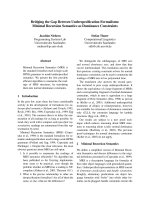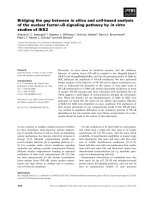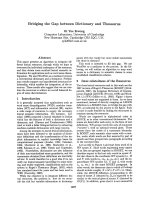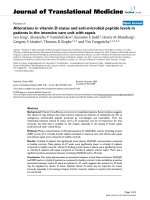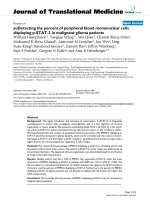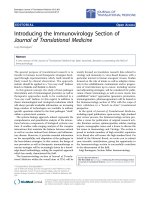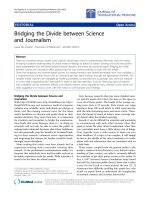Báo cáo hóa học: " Bridging the Divide between Science and Journalism" potx
Bạn đang xem bản rút gọn của tài liệu. Xem và tải ngay bản đầy đủ của tài liệu tại đây (192.72 KB, 3 trang )
EDITOR I A L Open Access
Bridging the Divide between Science
and Journalism
Laura Van Eperen
1
, Francesco M Marincola
2*
, Jennifer Strohm
1
Abstract
There are countless reasons nearly every scientist should learn how to communicate effectively with the media,
including increased understanding of critical research findings to attract or sustain funding and build new profes-
sional partnerships that will further propel forward research. But where do scientists begin? Bridging the Divide
between Science and Journalism offers practical tips for any scientist looking to work with the media.
Given the traditional and internet-based sources for medical research and healthcare-related news now available, it
is imperative that scientists know how to communicate their latest findings through the approp riate channels. The
credible media channels are managed by working journalists, so learning how to package vast, technical research
in a form that is appetizing and “bite-sized” in order to get their attention, is an art. Reducing years of research
into a headline can be extremely difficult and certainly doesn’t come naturally to every scientist, so this article pro-
vides suggestions on how to wor k with the media to communicate your findings.
Bridging the Divide between Science and
Journalism
With , , http://
DiagKNOWsis.org and numerous medical consumer
websites now available, more individuals are relying on
them, and t he eve ning network news for the late st
media headlines to educate and guide them in their
medical decisions. Now more than ever, it is important
for scientists and journalists to bridge the communica-
tion divide that exists between them [1]. In doing so,
scientists will not only be a ble to assist the public i n
making better informed decisions about their healthcare,
but also personally reap the benefits of increased fund-
ing for their research, enhanced career opportunities
and improving the chances for further scientific break-
throughs across disciplines.
Many reading this article may have already had an
experience working with a journalist coveri ng their
research. In the professional communications realm, it is
frequent that individuals ha ve h ad favorable and not so
favorable experiences with the media. With scientists, it
tends to be the latter for several reasons.
First, because research often has many detailed nuan-
ces and the media don’t have the time or the space to
cover all of those points. The length o f the average eve-
ning news story is 70 seconds. Print stories can range
anywhere from 100 word b riefs to 1000 word articles,
with the latter becoming more and more scarce. There-
fore, the format of much of today’s news coverage sim-
ply doesn’t allow for detailed reporting.
Second, it can be difficult for scientists and journalists
to communicate with each other because often they
speak in terms the other doesn’t understand. More than
ever, journalists must know a little about a lot of things.
They typically cover a wide variety of topics on very
short deadlines. If a topic is too complex, it will simply
be lost in th e shuffle of the other hundreds of e-mails,
phone calls and info rmati on t hey are inundated with on
a daily basis.
These issues, coupled with the general public’s (the
media’s readers/viewers/listeners) very limit ed under-
standing of basic science, can make it extremely difficult
for scientists to get their poin ts across in the media. In
fact, a 1997 National Science Foundation study found
that half the American public doesn’t know that it take s
a year for the Earth to rotate around the sun [2]. If
Americans have difficulty recalling that simple fact, why
wouldweexpectthemtounderstandthecomplexities
of scientific research and its latest discoveries?
* Correspondence:
2
Infectious Disease and Immunogenetics Section (IDIS), Department of
Transfusion Medicine, Clinical Center, National Institutes of Health, Bethesda,
Maryland, 20892, USA
Van Eperen et al. Journal of Translational Medicine 2010, 8:25
/>© 2010 Van Eperen et al; licensee BioMed Centr al Ltd. This is an Open Access artic le distributed under the terms of the Creative
Commons Attribution License ( which permits unrestricted use, distribution, and
reproduction in any medium, provided the original work is pr operly cited.
Most journalists fall into this group too. The over-
whelming majority of scientists surveyed in a First
Amendment Center, Freedom Forum study felt that few
in the media understand the nature of science and tech-
nology, with 72 percent saying that journalists do “face
a hopeless task in explaining the complexities of
science” [2].
Why Help Journalists Overcome the Complexities
of Science?
But why, beyond the benefit of th e public good, should
scientists take time out of their day to work with jour-
nalists? The answe r is simple. Clear communication and
greater awareness of your work can equal additional
funding, enhanced career advancement and further
scientific breakthrou ghs [3]. Acc ording to ht tp://p lain-
language.gov, a recent study showed that medical arti-
cles reported in The N ew England Journal of Medicine
and then reported in The New York Times receive about
73 percent more citations in medical reports than arti-
cles not reported in The New York Times. If a researcher
is able to successfully communicate his or her points in
The New York Times, chances are he or she also will be
able to more clearly communicate the value and neces-
sity if his or her work in a gra nt appli cation. According
to a National Science Foundation grant reviewer, the
cleares t and most succinct grant applications are usually
the most compelling. If a scientist can pitch his or her
grant proposal in three minutes or less, it has a better
chance at being funded [4]. The same is true with the
media. If you can communicate three or fewer compel-
ling points about the results of your study, you are more
likely to receive accurate and favorable coverage from
journalists and the resulting greater awareness of your
work.
Enhanced career opportunities also are a benefit to
working with the media. Scientists who have good com-
munications skills have a distinct advantage over their
less communicative colleagues when they compete for
prized positions. In addition, those scientists who are
cited more and have greater “awareness” -notjust
about their research, but also about themselves in their
fields - are more recognizable in their scientific commu-
nity, and are likely to be sought after.
Finally, let’s not overlook the fact that well-written
articles that are picked up by the press help stimulate
the “cross-fertilization” of research and ideas across
broad disciplines, therefore improving the chances for
even greater scientific breakthroughs.
Tips for Working with the Media
So what should researchers ke ep in mind when working
with the media? First, ask for help from the public
affairs and/or media specialists within your organization.
They are accustomed to working with the media on a
regular basis and can help best prepare you for maxi-
mizing the media opportunity. Here are a few more tips:
• Know Who You’ re Dealing With. Many general
consumer newsrooms a re shrinking a t a rapid pace
and today’s reporters are tasked with more resp onsi-
bilities and fewer resources. Therefore, there is less
time to interview credible professionals and fact-
check - lea ving greater potential for repo rters and
editors to get things wr ong. Also, know that repor-
ters are looking for stories and information that
their readers/viewers/listeners will f ind interesting.
So it is vital that you can quickly explain the results
of your research and put it into context about its
relevance. You must always be able to explain why
the information is new and exciting, and compelling
enough for a journalist to want to share that infor-
mation with hundreds of thousands of people.
• Communicate Simply and Clearly.Tohaveyour
work covered by the media, it is important to start
with a well-written executive summary-style docu-
ment, which outlines the key points of your findings.
Federal government employees, through The Plain
Lang uage Action and Informa tion Network (PLAIN),
offer many tips for drafting user- friendly documents
[5]. For instance, be sure to organize content to
make it easy t o understand with informative head-
ings and subheadings, bold and italicize terms when
appropriate, and use “plain language” such as writing
in short, clear sentences with common, every day
words, rather than indust ry jargon. For more tips,
visit . There you will
also f ind training resources off ere d by The Network
for researchers to take advantage of to improve com-
munications skills.
Note, when discussing plain language usage, profes-
sionals are told that researchers o ften gravitate
toward using technical language because that is what
their peers “expect.” However, it is argued that it is
more effective to use language and formatting that is
easy for everyone to understand and follow, no mat-
ter wha t the technical expertise. In doing so you will
reap the benefits of clear communication and greater
public awareness discussed earlier. A recent study by
the First Amendment Center funded by the Freedom
Forum also found this important in bridging the
divide between journalists and r esearchers. One of
the primary takeaways of the recent study is that it
is import ant for scientists to work with publishers of
scientific papers to include summaries of their find-
ings- written in plain En glish and that puts the work
into perspective and explains its relevance and
importance up front [2].
Van Eperen et al. Journal of Translational Medicine 2010, 8:25
/>Page 2 of 3
• Build Relationships. Peer-reviewed, published arti-
cles have added credibility that journalists like, but
they are not the only way to generate media interest
and coverage. And, even if an article is published in
a trade journal, there is a chance a mass-media jour-
nalist may miss it. Ask your public affairs/media spe-
cialists to help communicate your published work to
journalists to educate the public about it. They can
be helpful t o you by generating news relea ses and
other announcements about your work and distri-
buting the information to the right people in the
media. Also, be sure to get to know key repo rters
covering your field in the local and national media.
Often times these people can be found attending
major conferences and meetings. Introduc e yourself.
Briefly explain what you are working on and why it
is important. Ask what the reporter is working on
and see if you can be a resource to him or her.
Remember, most consumer reporters are often on
very tight deadlines and must find expert resources
for their stories quickly. Van Eperen & Company [6],
is one o f many strategic communications consulting
firms that has relationships w ith c onsumer and
health reporters and can help make this process go
smoothly. Keep in mind that any and all responses
are “on the record” and must be “quotable” - the key
here again is to limit jargon and unnecessary words.
Most important, the information you provide must
be timely and accurate.
Beyond yourself, try to have one or two other collea-
gues in mind that are comfortable commenting on
the subject and offer to put the reporter in touch
with them. Journalists like to include quotes from at
least two or three experts in stories to validate infor-
mation and a dd varying p erspectives. The more you
know about the media, the more you will begin to
realize that the best media spokespersons are subject
matter experts, they’re highly “quotable,” and they
readily make themselves available for interviews. If
you meet thes e requirements, the mor e likely it is
that you will be called back and included in future
stories!
A1997studybythePew R esearch Center for the Peo-
pleandthePressshowed a fifth of Americans polled
said they enjoyed stories about scienc e and te chnology.
That topic beat out r eligion, politics, international
affairs, entertainment, consumer news, business and
finance, famous people an d culture a nd the arts. About
thesametime,asurveybythenation’slargestnewspa-
per chain, the Gannett Company, showed that 75 per-
cent of readers were somewhat-to-very interested in
science and technology [2]. So if the public appetite is
there, then it is up to scientists and journalists to prop-
erly feed it.
Potential Conflicts
LVE and JS belong to a company discussed in this
manuscript and their article was solicited by FMM as an
editorial.
Author details
1
Van Eperen & Company, Strategic Communications Consulting, Bethesda,
MD 20817, USA.
2
Infectious Disease and Immunogenetic s Section (IDIS),
Department of Transfusion Medicine, Clinical Center, National Institutes of
Health, Bethesda, Maryland, 20892, USA.
Received: 4 March 2010 Accepted: 10 March 2010
Published: 10 March 2010
References
1. Plain Language. [ />whiteman.cfm].
2. Hartz J, Chappell R: Worlds apart: how the distance between science and
journalism threatens America’s future First Amendment Center, Freedom
Forum 1997.
3. Marincola E: Why is public science education important? J Transl Med
2006, 4:7.
4. Whiteman L: Wanted: articulate scientist. Science’s Next Wave. 2000.
5. Broderick IP: Reinventing government: the role of plain language Old
Dominion University 2009.
6. Van Eperen & Company: [].
doi:10.1186/1479-5876-8-25
Cite this article as: Van Eperen et al.: Bridging the Divide between
Science and Journalism. Journal of Translational Medicine 2010 8:25.
Submit your next manuscript to BioMed Central
and take full advantage of:
• Convenient online submission
• Thorough peer review
• No space constraints or color figure charges
• Immediate publication on acceptance
• Inclusion in PubMed, CAS, Scopus and Google Scholar
• Research which is freely available for redistribution
Submit your manuscript at
www.biomedcentral.com/submit
Van Eperen et al. Journal of Translational Medicine 2010, 8:25
/>Page 3 of 3
